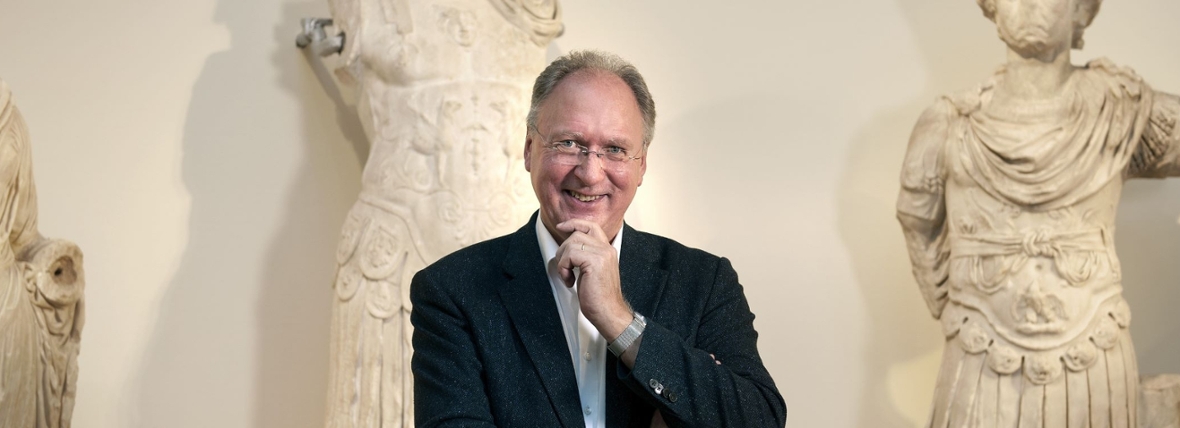
Leaving the National Museum of Antiquities after forty years: ‘I will be taking a gap year first’
On 14 May, curator and professor Ruurd Halbertsma will be leaving the National Museum of Antiquities (RMO) after forty years of dedicated service. In fact, it will be a double farewell: Venusval (‘Venus trap’), the last part of his trilogy about Tjalling Kingma, the fictional curator of the classical world at the National Museum of Antiquities, will be published on the same day.
When Halbertsma came to the National Museum of Antiquities on an internship in the 1980s, he found an inward-looking institution. Staff members concentrated on research, and exhibitions were just a side issue, which should definitely not take up too much time.
‘This changed completely when the national museums became independent at the end of the eighties,’ explains Halbertsma, looking round at the museum’s Temple Hall, where primary school children on their May holidays are sitting at long tables, working on craft activities. ‘These days, we work in partnership with the university, cultural institutions, theatre groups... And we now also present highly professional exhibitions, which means that the number of visitors has increased from 40,000 back then to 240,000 today. It’s incredibly rewarding to see so many people fascinated by antiquity.’
An office full of memories
Halbertsma closely witnessed this entire transformation. Starting as an intern with a dissertation on the nineteenth-century collector Jean Emile Humbert, he swiftly rose to the position of curator at the museum, which he combined with the role of professor by special appointment at the university. ‘As I was clearing out my office, I came across all kinds of things again,’ he says. ‘In the 1990s, for instance, I got a call from the English institution Receiver of Wreck. Amateur divers had found a ship that had been bringing antiquities to us from Turkey. I went to look at them in the divers’ homes. Such beautiful pieces! In consultation with the museum’s management, I filed a claim; and so too did the insurance company that had insured the items and also the Turkish government, which believed the items should never have been taken from Turkey.’
The Turkish government won the case. ‘I didn’t agree with it at the time, but with the benefit of hindsight, I can accept it now,’ says Halbertsma. ‘As with acquisitions, the thinking back then was: in a museum, it’s safe. It was only at the beginning of this century that our eyes were opened to looted art, partly due to revelations about how the art trade really operated.’

Thrillers for the general public
Halbertsma chose an original way to share these insights with the general public. Instead of appearing on talk shows or sending articles to newspapers, he wrote a thriller trilogy. The first two parts were about Jean Emile Humbert, the collector who had been the subject of Halbertsma’s dissertation, while the third is about the Flemish collector and army officer, Colonel Bernard Rottiers. ‘He collected—or rather, plundered—a lot of antiquities in Greece,’ says Halbertsma. ‘In 1825, a few years after the Venus de Milo was discovered, he started excavating at the same site. Those objects ended up in Europe, but in my book, the Louvre decides to return the Venus de Milo. That leads to all kinds of complications, in which my alter ego Tjalling Kingma also becomes involved.’
Gap year
For now, this is the last adventure that Tjalling will experience. ‘After the combined farewell and book presentation on 14 May, I will be taking a gap year, like high school graduates do after their final exams. I want to experience what it’s like not going to the museum, lecturing or writing every day; but just quietly enjoying time with my grandchildren and with my wife, doing nice things. Then I will see for myself what I miss.’
Teaching
Teaching seems likely to be one of the things he will miss. Armed with a slide projector, Halbertsma started giving lectures in the 1980s, just in his office. ‘I felt I could make more use of my knowledge of the history of archaeology,’ he recalls. ‘Professor Geertman of the Faculty of Archaeology thought it was a good idea too. He allowed me to pin a note on the notice board, saying that anyone interested could earn a few credits by attending my lectures. At first, there were just eight or nine students, but gradually the numbers increased. Suddenly, there were theses based on my lectures.’
In 2010, Halbertsma was even offered a position as professor by special appointment. In total, 38 students graduated under his supervision, and he served on 23 PhD committees. ‘Not bad for a sideline, right?’ he laughs. ‘It helped that the students who graduated with me were usually highly motivated. That made it incredibly enjoyable to supervise them.’
The growing interest also shows recognition of his field. Halbertsma says, ‘It’s wonderful to see how awareness of the past and the origins of objects has led to much greater appreciation of the history of archaeology.’
